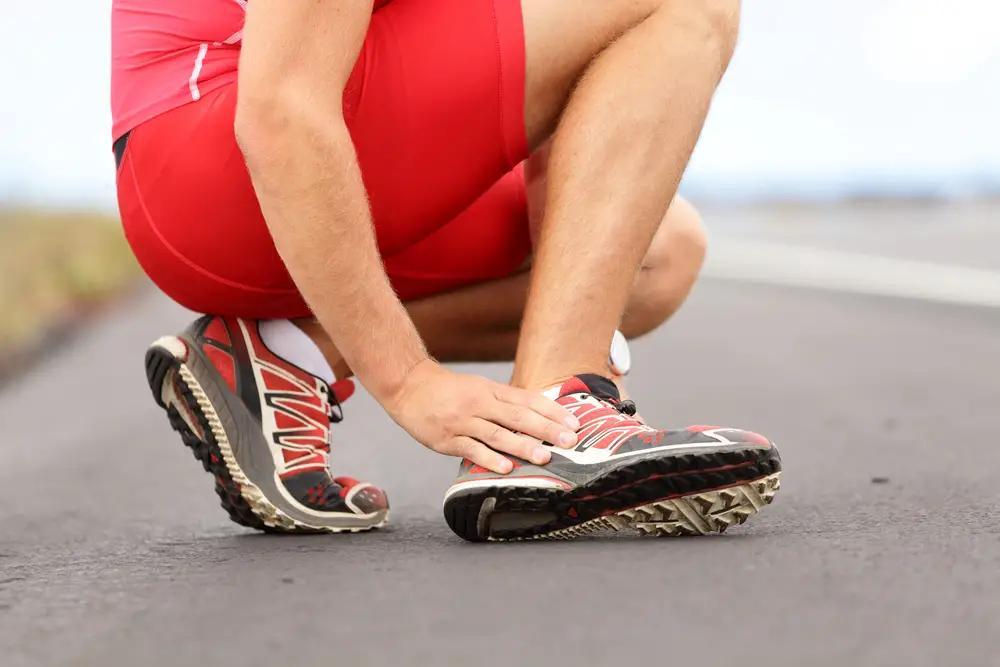Running is a widely embraced form of exercise known for its significant health advantages. However, it’s not without drawbacks, notably the risk of common running foot injuries. The constant impact of feet pounding the pavement can result in various foot ailments, posing a notable challenge for avid runners.

Awareness and prevention of these common issues are crucial for novice and seasoned runners to maintain their stride without pain or long-term damage.
Understanding the intricacies of foot anatomy and running biomechanics is essential in identifying the causes of foot injuries. The feet are complex structures that absorb significant impact during running. Each step can strain the muscles, tendons, and ligaments within the foot and ankle.
Injuries can arise from overuse, improper footwear, or running technique, making knowing these factors important for injury prevention and effective treatment strategies.
Key Takeaways
- Running can lead to foot injuries due to repetitive impacts on complex foot structures.
- Proper knowledge of foot anatomy and biomechanics is crucial in preventing running-related foot injuries.
- Identifying causes and implementing effective treatment strategies are key to maintaining healthy running habits.
Quick Navigation
Understanding Foot Anatomy and Running Biomechanics
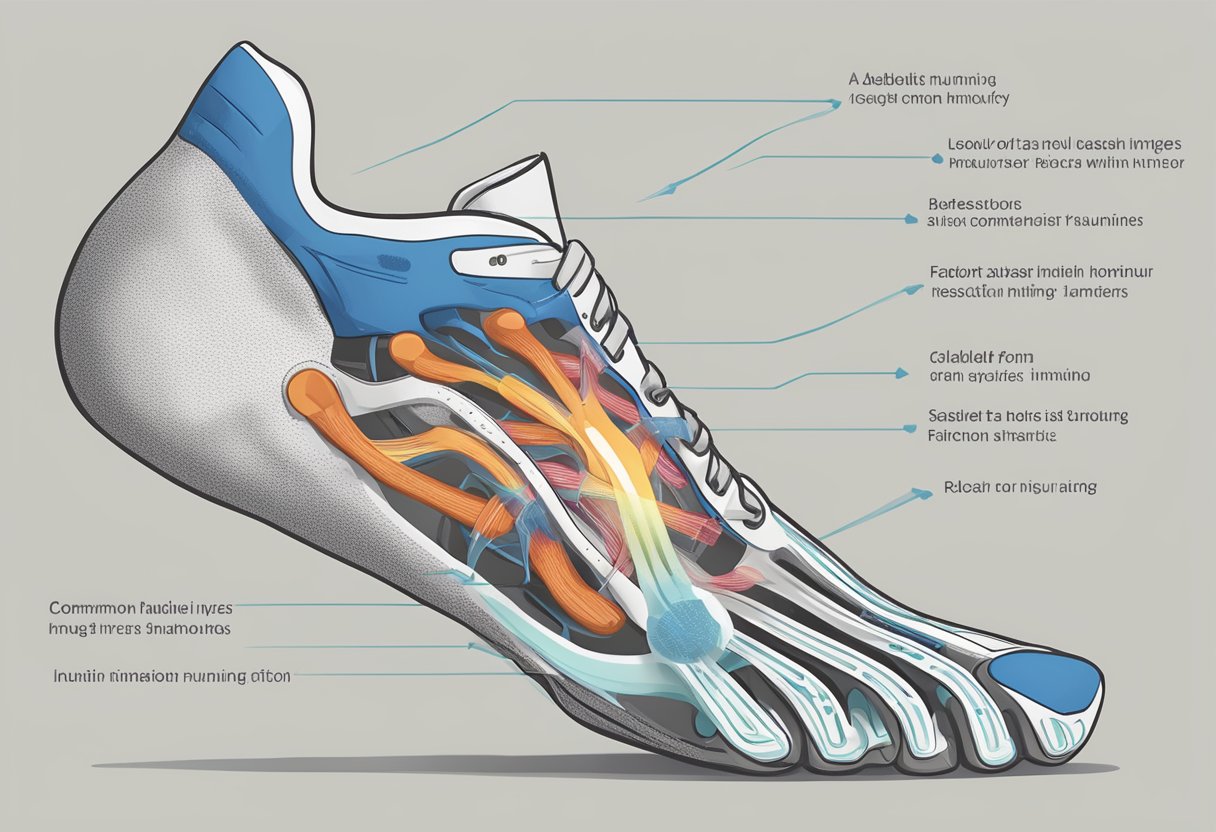
The health of a runner’s lower extremities is deeply entwined with the proper functioning of the foot’s complex structure and the biomechanics of running. This section explores the foot’s role in running and how biomechanical elements can influence injury risk.
Common Running Foot Injuries: Role of the Foot in Running
The foot serves as the foundation for movement, bearing the body’s full weight during a run. The bottom of the foot is the primary contact point with the ground and thus a critical element for the absorption of impact forces.
Specifically, the metatarsal bones engage during the toe-off phase, while the heel bone is the first to make contact during the foot strike, a moment that can define much of the force distribution throughout the gait cycle.
Several weight-bearing bones in the lower leg and foot, including the ankle joint, work in unison to provide the necessary stability and support.
Arch support is pivotal, as it contributes to absorbing and distributing the forces of running and plays a significant role in injury prevention.
An efficient foot strike and gait can minimize foot pain and ankle pain, often signals of underlying issues.
Biomechanical Factors Influencing Injury
Improper footwear is a common culprit in developing running-related injuries. Choosing running shoes that provide appropriate support and cushioning for one’s specific gait pattern is not just a good idea; it’s essential for injury prevention.
Conversely, shoes that do not match the runner’s foot type or running style can lead to an increased risk of injury.
Connective tissue strain, resulting from repetitive stress or biomechanical imbalances, often manifests as running injuries.
For instance, a runner experiencing a lack of arch support may suffer from conditions like plantar fasciitis.
Incorporating physical therapy and exercises to strengthen the foot and lower leg can improve resilience against such injuries, promoting a more robust and efficient running form.
Common Running Foot Injuries and Their Causes
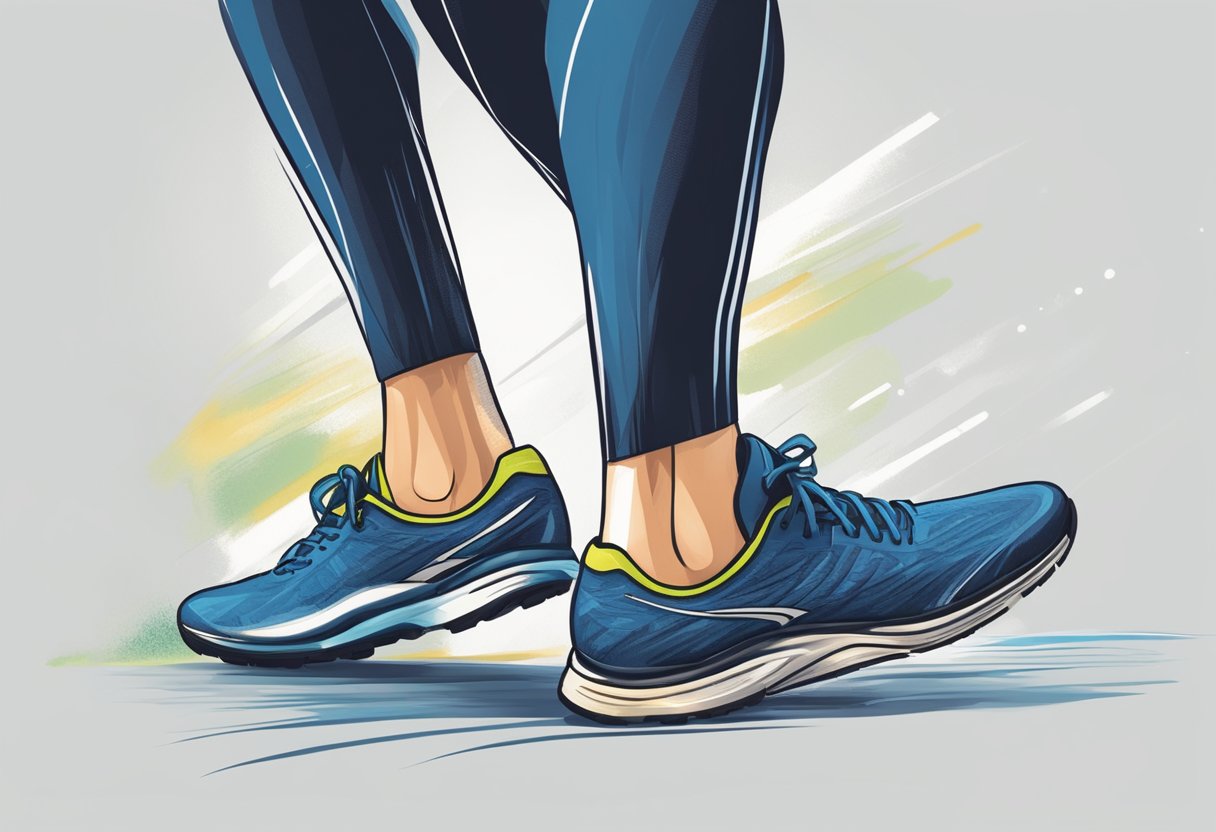
Running regularly can lead to various foot injuries, each with specific causes ranging from repetitive stress to improper footwear. The following sections offer insight into these common running-related ailments.
Stress Fractures and Their Impact
Stress fractures are tiny cracks in the bone often occurring in runners due to repetitive stress, particularly in the long bones of the foot. High mileage or intense training without adequate rest can lead to this overuse injury.
The continuous impact on hard surfaces exacerbates the problem, often resulting in heel or arch pain.
Tendinitis and Tendon Injuries
Tendon injuries, such as Achilles tendinitis, involve inflammation of the tendons caused by overuse or tight calf muscles.
The Achilles tendon, which connects the back of the heel to the calf muscles, is particularly susceptible. Symptoms include pain and limited range of motion.
Sprains and Strains
Ankle sprains are a common running injury and involve an overstretching or tearing of the ligaments that support the ankle. They result from a misstep or fall that forces the ankle out of its normal position.
Strains affect the muscles or tendons, often due to sudden overstretching.
Neuromas and Nerve-Related Issues
Morton’s neuroma thickens the tissue around the nerve between the third and fourth toes. Runners may experience sharp pain in the ball of the foot, often due to tight or narrow shoes that compress the toes or from high-impact running.
Overuse Syndromes and Their Symptoms
Repeated activity leads to overuse syndromes like plantar fasciitis, characterized by inflammation of the plantar fascia tendon. This condition manifests as a stabbing pain in the bottom of the foot, particularly upon waking. Contributing factors can include flat feet or high arches.
Impact of the Running Surface and Footwear
Running on hard surfaces for long distances increases the risk of shin splints and stress fractures, also known as medial tibial stress syndrome. Meanwhile, footwear that fails to provide adequate support or cushioning can lead to injuries like IT band syndrome.
Custom orthotics or shoes designed for specific foot types can mitigate some of these risks.
Common Running Foot Injuries:Diagnosis and Treatment
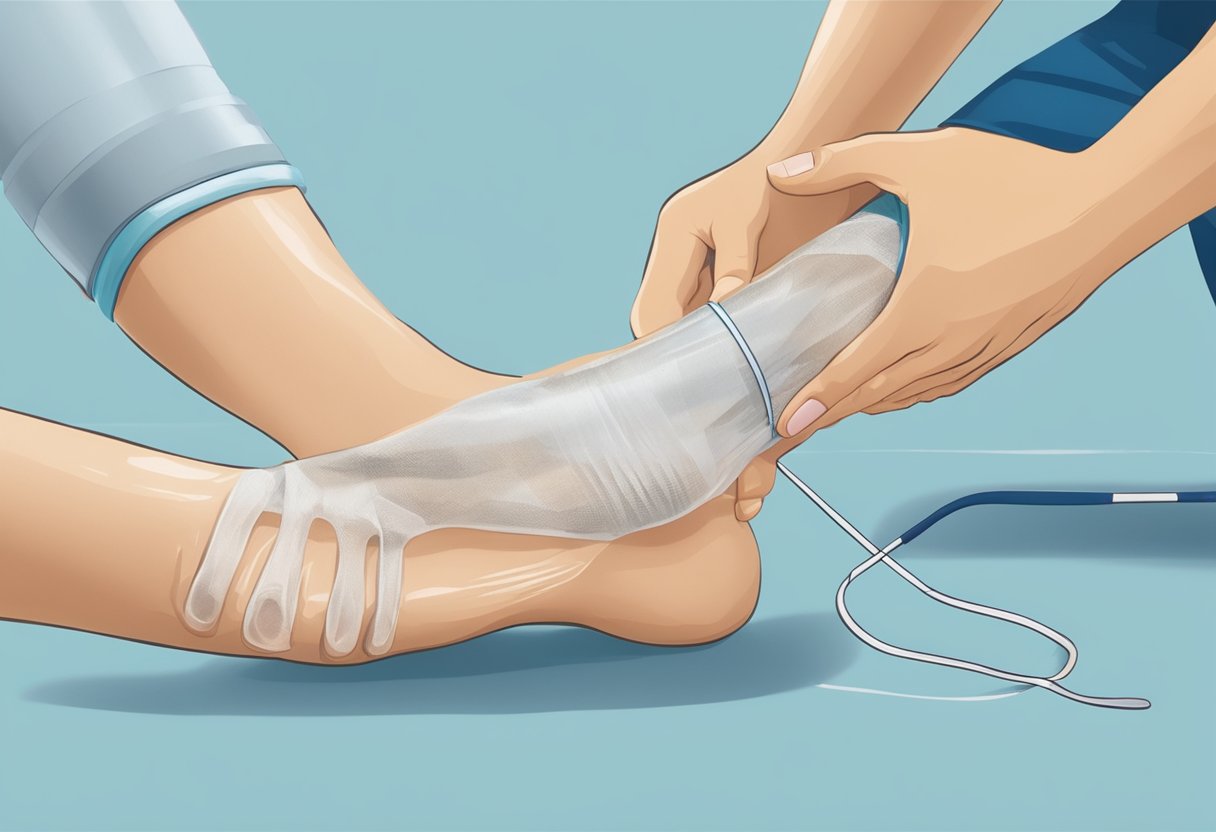
A thorough clinical assessment is fundamental to reaching a definitive diagnosis in addressing foot injuries in runners. Treatment options vary from conservative home remedies to professional medical interventions, each tailored to the severity of the condition.
Clinical Assessment and Diagnosis
When a runner presents with a foot injury, a primary care physician or sports medicine specialist will begin with a detailed history and physical examination.
Specific questions about the type of pain—intense pain suggestive of a serious injury or a dull ache—help identify the issue.
Diagnostic imaging may be necessary to confirm conditions like ingrown toenails or a black toenail. Noting symptoms of plantar fasciitis or assessing blood flow can also guide the diagnosis.
Conservative and Home Treatment Options
For many foot injuries, the first step in treatment is rest, ice, compression, and elevation (RICE) to manage swelling and pain relief.
Anti-inflammatory medications can help reduce pain and inflammation. Strength training and stretching exercises are a great way to promote healing and prevent future injuries.
For runners experiencing mild symptoms, modifying their running routine to decrease the impact on the feet can relieve pain.
Professional Medical Interventions
When conservative treatments are not enough, seeking the expertise of a specialist, such as an ankle surgeon or physical therapist, may be necessary.
Physical therapy focuses on tailored exercises that improve strength, flexibility, and correct biomechanics. In some cases, orthotic devices or corticosteroid injections are recommended.
Surgical intervention is reserved for more severe cases where non-surgical treatment options are ineffective.
Prevention Strategies and Long-Term Care
Reducing the risk factors for foot injuries involves incorporating strength training into one’s regimen and wearing proper footwear designed for the shape of the foot and style of running.
Long-term care might also include a running routine that varies in intensity and terrain to foster good musculoskeletal health.
Maintaining a healthy weight and listening to one’s body to avoid overtraining are crucial prevention strategies. Regular check-ups with a healthcare provider can keep runners on track and decrease the chances of painful conditions developing.
Additional Considerations for Runners
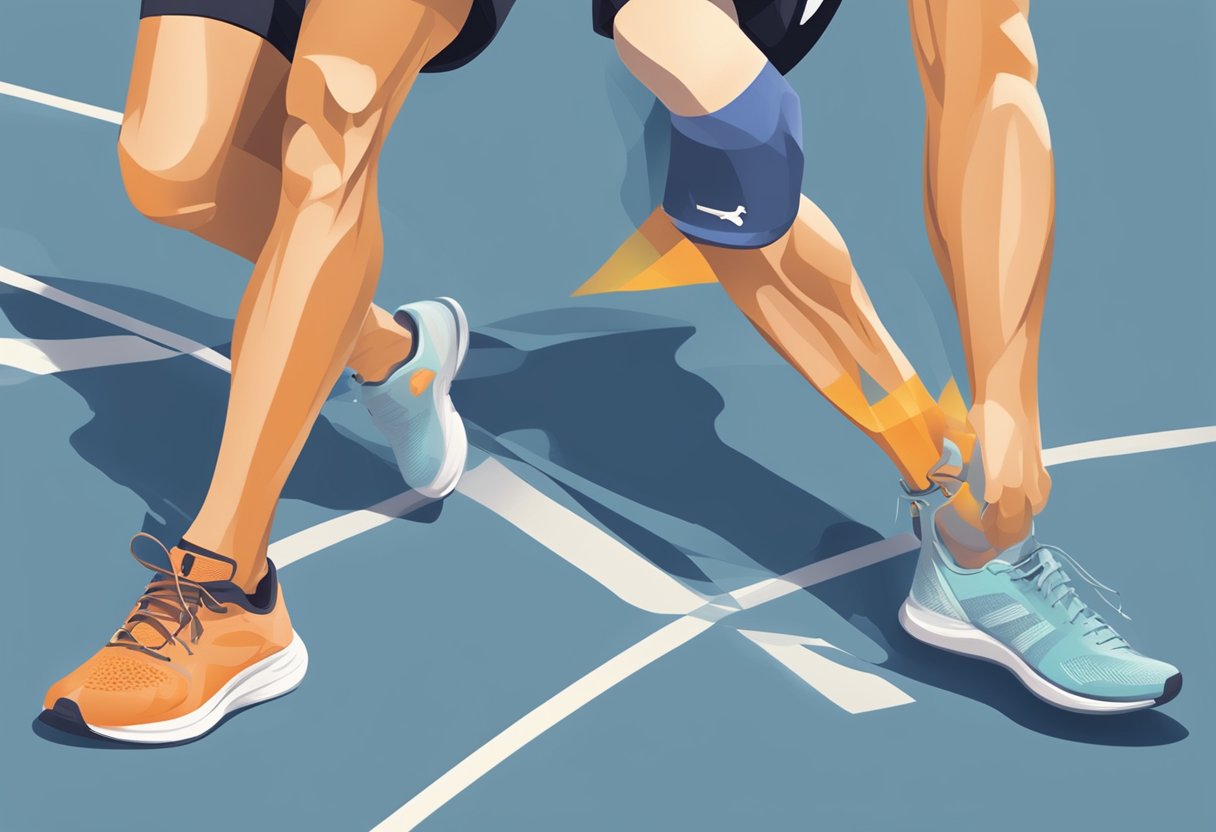
When elevating their running experience, runners need to focus on creating a sustainable running program and ensure proper recovery to protect the lower body and particularly the feet—an area often bearing the brunt of exertion.
Common Running Foot Injuries: Developing a Running Program
A smart running regimen balances intensity and volume to match an individual’s fitness level.
Runners should prioritize selecting the right running shoes that offer adequate support for their gait and the terrain they’re tackling.
Integrating variety into their routines, such as mixing short sprints with long runs, is a good idea to engage different posterior muscles without applying excessive force to a singular affected area.
Cross-training can help develop strength and flexibility, reducing the odds of a running injury.
The Importance of Proper Recovery
Recovery should never be an afterthought. It is as vital as the run itself for longevity in the sport.
Runners should pay attention to their affected foot after intense sessions. They should apply ice if necessary to mitigate inflammation.
Physical therapy exercises can be beneficial for relieving tight muscles. They also ensure that the muscles and tendons in the lower body are well-conditioned.
Moreover, post-run routines such as stretching, foam rolling, or yoga can assist in maintaining flexibility. They can also be the best thing to prevent overuse injuries.
Regular rest days are essential to allow the body to rebuild and strengthen.
Common Running Foot Injuries: Conclusion
Understanding and addressing common running foot injuries is essential for anyone engaged in this popular form of exercise. Runners can take proactive steps toward treatment and prevention by recognizing the signs of injuries such as stress fractures, tendinitis, sprains, strains, and neuromas.
Incorporating knowledge of foot anatomy, biomechanics, and the impact of running surfaces and footwear into your routine can significantly reduce the risk of injury.
Emphasizing the importance of proper footwear, cross-training, and recovery strategies, including the RICE method and physical therapy, can help maintain foot health and ensure a long, pain-free running journey.
Remember, prevention is always better than cure, and by staying informed about common running foot injuries, runners can enjoy the benefits of this activity while minimizing the risks.

